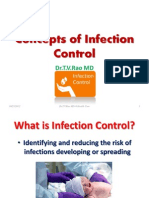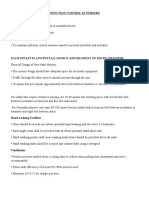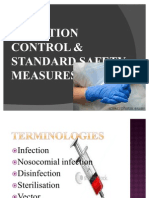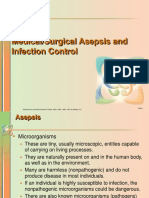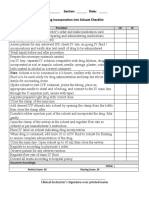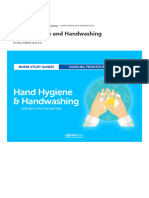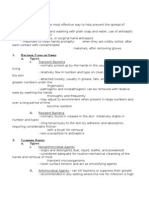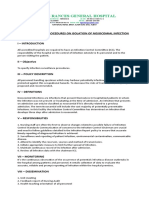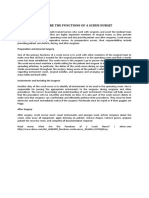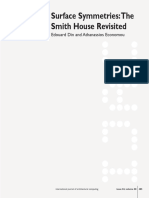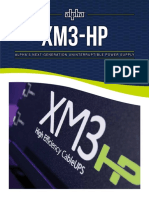100%(2)100% found this document useful (2 votes)
295 viewsInfection Control
Infection Control
Uploaded by
Sheryl ReyesInfection control pertains to measures taken to prevent infections in healthcare settings by breaking the chain of infection. There are two types of asepsis used: medical asepsis which uses clean techniques like handwashing and disinfection to prevent direct or indirect transfer of pathogens, and surgical asepsis which uses sterile techniques in operating rooms to keep objects and areas sterile. Standard precautions are used for all patients while transmission-based precautions have three types - airborne, droplet, and contact - used in addition to standard precautions for patients with highly transmissible pathogens. Source and protective isolation are also used to isolate contagious patients and protect vulnerable patients respectively.
Copyright:
© All Rights Reserved
Available Formats
Download as PPTX, PDF, TXT or read online from Scribd
Infection Control
Infection Control
Uploaded by
Sheryl Reyes100%(2)100% found this document useful (2 votes)
295 views13 pagesInfection control pertains to measures taken to prevent infections in healthcare settings by breaking the chain of infection. There are two types of asepsis used: medical asepsis which uses clean techniques like handwashing and disinfection to prevent direct or indirect transfer of pathogens, and surgical asepsis which uses sterile techniques in operating rooms to keep objects and areas sterile. Standard precautions are used for all patients while transmission-based precautions have three types - airborne, droplet, and contact - used in addition to standard precautions for patients with highly transmissible pathogens. Source and protective isolation are also used to isolate contagious patients and protect vulnerable patients respectively.
Original Description:
INFECTION CONTROL
Copyright
© © All Rights Reserved
Available Formats
PPTX, PDF, TXT or read online from Scribd
Share this document
Did you find this document useful?
Is this content inappropriate?
Infection control pertains to measures taken to prevent infections in healthcare settings by breaking the chain of infection. There are two types of asepsis used: medical asepsis which uses clean techniques like handwashing and disinfection to prevent direct or indirect transfer of pathogens, and surgical asepsis which uses sterile techniques in operating rooms to keep objects and areas sterile. Standard precautions are used for all patients while transmission-based precautions have three types - airborne, droplet, and contact - used in addition to standard precautions for patients with highly transmissible pathogens. Source and protective isolation are also used to isolate contagious patients and protect vulnerable patients respectively.
Copyright:
© All Rights Reserved
Available Formats
Download as PPTX, PDF, TXT or read online from Scribd
Download as pptx, pdf, or txt
100%(2)100% found this document useful (2 votes)
295 views13 pagesInfection Control
Infection Control
Uploaded by
Sheryl ReyesInfection control pertains to measures taken to prevent infections in healthcare settings by breaking the chain of infection. There are two types of asepsis used: medical asepsis which uses clean techniques like handwashing and disinfection to prevent direct or indirect transfer of pathogens, and surgical asepsis which uses sterile techniques in operating rooms to keep objects and areas sterile. Standard precautions are used for all patients while transmission-based precautions have three types - airborne, droplet, and contact - used in addition to standard precautions for patients with highly transmissible pathogens. Source and protective isolation are also used to isolate contagious patients and protect vulnerable patients respectively.
Copyright:
© All Rights Reserved
Available Formats
Download as PPTX, PDF, TXT or read online from Scribd
Download as pptx, pdf, or txt
You are on page 1of 13
At a glance
Powered by AI
The document discusses infection control, the concept of asepsis, medical asepsis, surgical asepsis, standard precautions, and transmission-based precautions.
The two main types of asepsis are medical asepsis and surgical asepsis. The goal of medical asepsis is to exclude pathogens, while the goal of surgical asepsis is to render and keep objects and areas sterile.
The steps involved in surgical aseptic technique include scrubbing hands and fingernails before entering the operating room, using sterile gloves, masks, gowns and shoe covers, using sterile solutions and dressings, using sterile drapes and creating a sterile field, and using heat-sterilized surgical instruments.
Infection Control
Dr. Sheryl M. Reyes
What is infection Control?
Pertains to the numerous measures that are taken to prevent infections from
occurring in health care settings.
Ways to break various links in the chain of infection
ASEPSIS
Wound contamination is not inevitable and that pathogens can be prevented
from reaching vulnerable areas ASEPSIS WITHOUT INFECTION
TWO TYPES OF ASEPSIS:
1. Medical Asepsis
2. Surgical Asepsis
1.Medical Asepsis
also Known as Clean Technique
Includes all the precautionary measures necessary to prevent direct transfer of
pathogens from person to person and indirect transfer of pathogens fomites
Includes: 1. frequent and thorough handwashing
2. personal grooming
3. proper cleaning of supplies and equipment
4. disinfection
5. proper disposal of needles ,contaminated materials, and infectious
waste
6. sterilization
GOAL: to Exclude Pathogens
Surgical Asepsis
Also known as Sterile Technique
Includes practices used to render and keep objects and areas sterile
This is practiced in operating Rooms, labor and Delivery areas, certain areas of
hospital laboratory and at patients bedside
Surgical Aseptic Technique Includes:
1. scrubbing hands and fingernails before entering OR
2. using sterile gloves, masks, gowns and shoe covers
3. using sterile solutions and dressings
4. using sterile drapes and creating a sterile field
5. using heat-sterilized surgical instruments
Standard Precautions (as defined by
CDC in 1996)
Transmission Based Precautions
Designed for patients known or suspected to be infected with highly
transmissible or epidemiologically important pathogens for which additional
precautions beyond standard precautions are required to interrupt
transmission within hospitals.
3 types of Transmission Based Precautions:
1. airborne precautions
2. droplet precautions
3. contact precautions
Note: these are used in addition to the standard precautions already being
used
Airborne precautions
Source Isolation
When patients with tuberculosis or other contagious diseases are placed
into isolation to protect other people from becoming infected
isolation room are usually under negative pressure to prevent room air from
entering the hallway when the door is opened, and air that is evacuated from
such rooms passes through HEPA filters to remove pathogens
Protective Isolation
Certain patients are especially vulnerable to infections, i.e severe burns, leukemia ,
patients who received transplant, immunosuppressed persons, those receiving
radiation treatments, and leukopenic patients, premature infants
Also known as reverse isolation or neutropenic isolation
Patients are placed in a TOTAL PROTECTED ENVIRONMENT (TPE)
TPE includes a private room in which vented air entering the room is passed
through HEPA filters
Room is positive pressure to prevent hallway air from entering when the door is
opened
All items coming in contact with the patient must be disinfected or sterilized
Persons entering room must wear sterile gowns , masks, gloves, caps and shoe
covers
You might also like
- CloudFoundations - 04 - AWS Cloud SecurityDocument54 pagesCloudFoundations - 04 - AWS Cloud SecurityJan jan1100% (2)
- Infection Prevention BrochureDocument2 pagesInfection Prevention BrochureTeguh Aprian Maulana GultomNo ratings yet
- Role of Nursing in Infection ControlDocument54 pagesRole of Nursing in Infection Controltummalapalli venkateswara rao80% (5)
- Engineering Mathematics II Formulas Studyhaunters PDFDocument13 pagesEngineering Mathematics II Formulas Studyhaunters PDFSriram J50% (2)
- Worksheet 3: Lines, Angles and Shapes: Extended Revision Exercises: Shape, Space and MeasuresDocument3 pagesWorksheet 3: Lines, Angles and Shapes: Extended Revision Exercises: Shape, Space and Measuresmk hat60% (5)
- Martha Rogers Case Study With AnswersDocument2 pagesMartha Rogers Case Study With Answersapi-239034911100% (3)
- 1 Infection Prevention and ControlDocument57 pages1 Infection Prevention and Controlmariam100% (3)
- Concepts of Infection ControlDocument53 pagesConcepts of Infection ControlPak Pandir0% (1)
- Safety and Infection Control QuestionsDocument8 pagesSafety and Infection Control QuestionsArjay Dionisio100% (1)
- Windows 10 SDK WDK Redist ListDocument7 pagesWindows 10 SDK WDK Redist ListQuyền NguyễnNo ratings yet
- 5.infection Control & Standard PrecautionsDocument33 pages5.infection Control & Standard PrecautionsGilbert JohnNo ratings yet
- Standard Precaution HandoutDocument3 pagesStandard Precaution Handoutaringkinking100% (2)
- Infection Control Practices in WorkplaceDocument28 pagesInfection Control Practices in WorkplaceJames Patrick Dizon100% (1)
- MODULE 7 Infection ControlDocument43 pagesMODULE 7 Infection ControlBitoy AlarconNo ratings yet
- Infection Control and SSMDocument60 pagesInfection Control and SSMsomaNo ratings yet
- Unit 3-Infection ControlDocument108 pagesUnit 3-Infection Controltau88100% (1)
- Infection Control Lecture For Nursing AttendantsDocument28 pagesInfection Control Lecture For Nursing Attendantsmark andradaNo ratings yet
- Infection Prevention and Control SpeakerDocument28 pagesInfection Prevention and Control Speakerfouzia100% (3)
- Outbreak Control POLICYDocument11 pagesOutbreak Control POLICYAdrian SavastitaNo ratings yet
- Concepts of Infection ControlDocument61 pagesConcepts of Infection Controltummalapalli venkateswara rao100% (1)
- 14 Infection ControlDocument27 pages14 Infection ControlMichelle Joy M. VicenteNo ratings yet
- CD Summer Review 1Document157 pagesCD Summer Review 1Nikko MelencionNo ratings yet
- Infection Control in NurseryDocument5 pagesInfection Control in Nurserysandeepv08No ratings yet
- Infection Prevention ControlDocument9 pagesInfection Prevention ControlIchilon Tamoto0% (1)
- Isolation Practices & Sterile Technique: NCM 101 - RLE 2 Semester 2018 Prepared By: MmsantosDocument91 pagesIsolation Practices & Sterile Technique: NCM 101 - RLE 2 Semester 2018 Prepared By: MmsantosnicNo ratings yet
- Management of Infection Prevention and ControlDocument20 pagesManagement of Infection Prevention and ControlAnna DixonNo ratings yet
- International Patient Safety Goals - 24 September 2021Document43 pagesInternational Patient Safety Goals - 24 September 2021Yunus ElonNo ratings yet
- Infection Control LectureDocument21 pagesInfection Control LectureJessica Medina100% (1)
- Hand Washing & Infection ControlDocument28 pagesHand Washing & Infection ControlDr Vijay Pratap Raghuvanshi94% (16)
- File 571Document65 pagesFile 571RazaCreciaLastrillaMenesesNo ratings yet
- Infection ControlDocument42 pagesInfection ControlNidhin Thomas67% (3)
- NCM 101 Vital Signs PPT BSN 1a Group 1Document138 pagesNCM 101 Vital Signs PPT BSN 1a Group 1Brian Anthony100% (1)
- Infection Control MeasuresDocument33 pagesInfection Control Measuresclaire yowsNo ratings yet
- Prevention and Control of InfectionsDocument21 pagesPrevention and Control of InfectionsSunil ThomasNo ratings yet
- Asepsis and Infection ControlDocument64 pagesAsepsis and Infection ControlSara Sabra100% (1)
- Safety and Infection ControlDocument7 pagesSafety and Infection Controlarcci balinasNo ratings yet
- Patient SafetyDocument22 pagesPatient SafetyRensy Sabi100% (1)
- Enloe infectionPreventionAndControl QuizDocument3 pagesEnloe infectionPreventionAndControl QuizsarahhNo ratings yet
- IV and GCS ChecklistDocument2 pagesIV and GCS ChecklistEricka Shayne Andaya100% (2)
- Asepsis and Infection ControlDocument10 pagesAsepsis and Infection ControlgilissaNo ratings yet
- Contrast and Special Radiographic Procedures: Topic - Aseptic TechniquesDocument15 pagesContrast and Special Radiographic Procedures: Topic - Aseptic TechniquesPOOJA MNo ratings yet
- Infection Control: Submitted by Mrs Gayathri R 2 Yr MSC (N) UconDocument38 pagesInfection Control: Submitted by Mrs Gayathri R 2 Yr MSC (N) UconGayathri R100% (2)
- Isolation PrecautionsDocument13 pagesIsolation Precautionsmalyn1218No ratings yet
- Universal Precaution by FithriDocument62 pagesUniversal Precaution by FithriFithriKurniatiNo ratings yet
- Annex G - Infection Control Annual Plan 2012-13Document7 pagesAnnex G - Infection Control Annual Plan 2012-13Tianti PuadiNo ratings yet
- Donning and Doffing of PPEDocument8 pagesDonning and Doffing of PPELuaña Jacqueline100% (1)
- Infection Control BasicsDocument10 pagesInfection Control BasicsAlan Amato100% (1)
- Vital SignsDocument94 pagesVital Signsglennm68100% (5)
- Infection Control: Evangeline H, SKPDocument49 pagesInfection Control: Evangeline H, SKPEvangeline HutabaratNo ratings yet
- Communicable Nursing - LecturervDocument329 pagesCommunicable Nursing - LecturervCarl WaletNo ratings yet
- Hand Hygiene and Handwashing - NurseslabsDocument9 pagesHand Hygiene and Handwashing - NurseslabsAndrea BarragánNo ratings yet
- Handwashing - PPEDocument14 pagesHandwashing - PPEdlneisha61100% (2)
- Hospital Infection Control Manual AIIMS Raipur2019 (Word)Document204 pagesHospital Infection Control Manual AIIMS Raipur2019 (Word)Dipali SolankiNo ratings yet
- Surgical Handwashing Resource Material 2023-2024Document9 pagesSurgical Handwashing Resource Material 2023-2024Cherry Louise O. SanvictoresNo ratings yet
- 8 Decontamination Disinfection SterilizationDocument8 pages8 Decontamination Disinfection SterilizationJay Villasoto100% (1)
- Infc ContrlDocument36 pagesInfc ContrlgopscharanNo ratings yet
- Policies and Procedures On Isolation of Nosocomial InfectionDocument8 pagesPolicies and Procedures On Isolation of Nosocomial InfectionMelba AlanoNo ratings yet
- What Are The Functions of A Scrub NurseDocument24 pagesWhat Are The Functions of A Scrub NurseBrigette Jane Michelle Martil100% (1)
- Aseptic TechniqueDocument7 pagesAseptic TechniquerameshaachariarNo ratings yet
- Aseptic Techniques (2022)Document65 pagesAseptic Techniques (2022)Usama SeleimNo ratings yet
- Hospital Infection Control: Cecilia S. Montalban, MD, MSCCTMDocument51 pagesHospital Infection Control: Cecilia S. Montalban, MD, MSCCTMDelantar Percivic100% (1)
- Aseptic Technique: Technical Skills Core CurriculumDocument44 pagesAseptic Technique: Technical Skills Core CurriculumAbby GailNo ratings yet
- Basic Clinical Nursing SkillsDocument43 pagesBasic Clinical Nursing Skillsaibaloca100% (1)
- NURSING EMERGENCIES. 10 BASED TEST QUESTIONS WITH BIBLIOGRAPHYFrom EverandNURSING EMERGENCIES. 10 BASED TEST QUESTIONS WITH BIBLIOGRAPHYNo ratings yet
- Edentulous Alveolar RidgeDocument29 pagesEdentulous Alveolar RidgeSheryl ReyesNo ratings yet
- Functional Organization of The Human Body and HOMEOSTASISDocument10 pagesFunctional Organization of The Human Body and HOMEOSTASISSheryl ReyesNo ratings yet
- The Microscope: Dr. S.M. ReyesDocument9 pagesThe Microscope: Dr. S.M. ReyesSheryl Reyes100% (1)
- Epidemiology: Dr. Sheryl M. ReyesDocument19 pagesEpidemiology: Dr. Sheryl M. ReyesNilda ReyesNo ratings yet
- Vap Care Bundle FinalDocument4 pagesVap Care Bundle FinalMother of Mercy Hospital -Tacloban Inc.No ratings yet
- 3rd Quarter Examination '23Document3 pages3rd Quarter Examination '23rhenz marie cadelinia germanNo ratings yet
- Anas PBLDocument22 pagesAnas PBLAnas FareedNo ratings yet
- Management of Non-Carious LesionsDocument22 pagesManagement of Non-Carious LesionsMohamed KilaniNo ratings yet
- Lecture1 IntroductionDocument67 pagesLecture1 IntroductionMariem El MechryNo ratings yet
- Persian Loanwords EALLDocument5 pagesPersian Loanwords EALLLuca DötterböckNo ratings yet
- Surface Symmetries The Smith House Revis PDFDocument22 pagesSurface Symmetries The Smith House Revis PDFAlisson CabreraNo ratings yet
- Complication On Labor and DeliveryDocument5 pagesComplication On Labor and DeliveryMeryville JacildoNo ratings yet
- Syllabus in PsychiatryDocument7 pagesSyllabus in PsychiatryMohammad AlHamdanyNo ratings yet
- AQA Core 1 RevisionDocument15 pagesAQA Core 1 Revisionjake1731No ratings yet
- When Life Throws You A CurveDocument168 pagesWhen Life Throws You A CurveAlfreo Wilson FinnNo ratings yet
- Engineering Graphics Manual Final PDFDocument98 pagesEngineering Graphics Manual Final PDFPradeep AppuNo ratings yet
- Purnomo Et Al 2024 Tctap C 189 A Difficult Strategy of Double Trouble Acute Limb Ischemia and Asymptomatic Severe IliacDocument2 pagesPurnomo Et Al 2024 Tctap C 189 A Difficult Strategy of Double Trouble Acute Limb Ischemia and Asymptomatic Severe IliacM. PurnomoNo ratings yet
- Installation and Maintenance Instructions Reflector CondorledDocument2 pagesInstallation and Maintenance Instructions Reflector CondorledDiseño Lexu LightNo ratings yet
- Master Budget QuestionsDocument19 pagesMaster Budget QuestionsSwathi Ashok100% (3)
- Testimonial Template For Secondary SchoolDocument2 pagesTestimonial Template For Secondary Schooladebolaadebayo98No ratings yet
- Project Management - Chapter 2Document2 pagesProject Management - Chapter 2Azfar JavaidNo ratings yet
- Post-Classical Philosophical CommentariesDocument32 pagesPost-Classical Philosophical Commentariesrock3tmnNo ratings yet
- Daily Lesson Plan Technology and Livelihood Education Pascual M. Osuyos Memorial High SchoolDocument7 pagesDaily Lesson Plan Technology and Livelihood Education Pascual M. Osuyos Memorial High Schoollourene guanzon67% (3)
- Ai Paper Draft FormattedDocument31 pagesAi Paper Draft FormattedSweta DeyNo ratings yet
- 1st Experiment PDFDocument115 pages1st Experiment PDFlakshmiNo ratings yet
- Noun ClausesDocument27 pagesNoun ClausesThu Cuc100% (1)
- Hyd Arm DWGDocument6 pagesHyd Arm DWGYağız YiğitNo ratings yet
- Alpha'S Next-Generation Uninterruptible Power Supply: With Handle: 7.8 X 16.7 X 10.7 / 198.1 X 424.18 X 271.8Document6 pagesAlpha'S Next-Generation Uninterruptible Power Supply: With Handle: 7.8 X 16.7 X 10.7 / 198.1 X 424.18 X 271.8federicosanchezNo ratings yet
- p1632 eDocument4 pagesp1632 ejohn saenzNo ratings yet



















